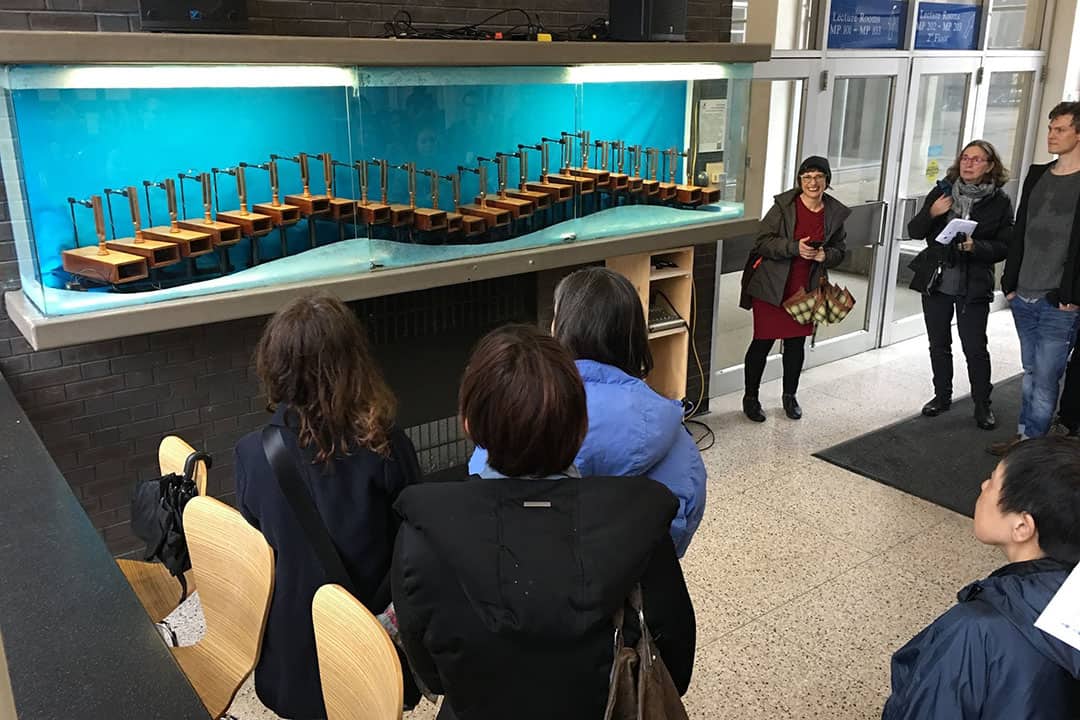“I am a hybrid creature trying to balance research, artistic practice and curation, at the intersection of art and science,” wrote Roberta Buiani, an artistic director and lecturer at the University of Toronto in an email to The Varsity.
In academia, the disciplines of art and science are often established as two independent and incompatible structures. This is not the case for Buiani, who, as a co-founder of the ArtSci Salon alongside U of T Professor of Geophysics Setphen Morris, strives to bridge the divide between the two fields of study.
Inspired by Jim Ruxton, the organizer of a platform known as the Subtle Technologies, Buiani and Morris invented the ArtSci Salon as an off-shoot of the festival to cater to the growing community of scientists and artists seeking collaborations within the GTA. The salon has since established itself as an independent program that is steadily expanding. Throughout the year, art, science, and tech enthusiasts meet to organize events aimed at facilitating dialogue on topics that pertain to both the arts and the sciences.
With an extensive educational background in the arts, Buiani is the mastermind behind the artistic facet of ArtSci Salon.
Buiani began her post-secondary education in Bologna, Italy, where she obtained a Bachelor of Arts in Literature. While studying abroad, the lack of clubs and extracurricular activities led to an education primarily shaped by the bustling culture of Bologna itself.
“[Bologna] was incredibly vibrant with culture and events, and… political activism,” Buiani wrote. Following this formative experience, Buiani completed a Masters in Art History, a PhD in Communication and Culture, two postdoctoral fellowships in the United Kingdom and Canada, and acquired “a professional background in Project Management and Digital Media production.”
In the present day, Buiani has focused her achievements toward her projects at the University of Toronto. “The type of work that I have been doing at the university is divided evenly between research and creation, curatorial work and teaching, [although] the university does not recognize officially the first two,” she said.
“I am fascinated by the way conventions and routine have made us absolutely unable to think outside the box and to imagine things beyond their so-called default uses,” Buiani continued. “Much of my work tries to change this.”
She said that boredom and routine have generated her desire to bring something new and innovative like ArtSci Salon into the Toronto community.
“It is a personal journey,” she said, reflecting on a recent ArtSci Salon venture known as the Cabinet Project. “I appropriated several abandoned glass cabinets around the St. George campus and asked artists to populate them with installations featuring art and science collaborations. The goal was to show the sciences under a different light and to reconnect alienated academic spaces with the architecture and the cultural vibrancy of the city.”
Since its creation, ArtSci Salon has advanced in reputation and participation. It is also open to the public, drawing the attention of students from other universities who are looking to volunteer or collaborate.
“It doubles as an outreach project and an inspiration for the science community,” Buiani added, “but it also offers space and opportunity to artists who want to take up the challenge and work with scientific objects and technologies.”
Given that the facets of the arts and the sciences are so diverse, students may feel pressure to choose between the two disciplines rather than understand how both can be functionally relatable. Buiani agrees that the roles of artists and curators are still widely misunderstood in the world of science, and similarly, that scientific research is often misinterpreted by artists and curators.
However, the objective of her work is straightforward: to further the understanding that technology, science, and arts are all entwined. “Specifically, we want to stir discussions and foster collaborations at the intersections of disciplines and to bridge different professional and cultural languages.”
“Our audience has become increasingly sophisticated in addressing issues regarding the topics and the projects proposed,” she continued. “We really want people to improve their literacy in science, without ceasing to think critically. We also want people to think beyond Western-centric and hegemonic science.”
Buiani feels that the movement of STEM to STEAM (science, technology, engineering, arts, and mathematics) would do injustice to the arts.
“Unfortunately, this is still interpreted as a way to embellish science with the arts, or to use the arts to do outreach,” Buiani expressed. “Adding the ‘A’ in STEM for us means demonstrating how arts and sciences can benefit mutually from each other through collaboration that shares research and methods rather than provides a service.”
For now, ArtSci Salon has been promoting itself to young scholars and undergraduate students, but not without difficulty. Buiani noted that many students, especially in the sciences, are often engaged in heavy amounts of coursework and may be unmotivated to attend events beyond their field of study.
Nevertheless, Buiani is hopeful that ArtSci Salon will continue to expand with time as the project becomes more widely known. Students are welcome to propose ideas for future events and are encouraged to get involved in the various positions that are available.
“I enjoy immensely the intellectual enrichment that comes from interactions with my colleagues,” remarked Buiani. “My hope is to create events that engage critically with topics in science, the high tech industry, and the arts that are often obscured.”


